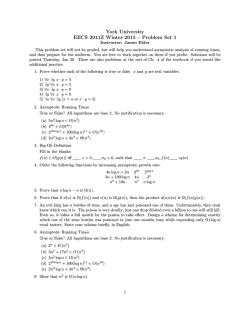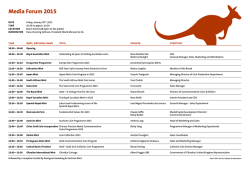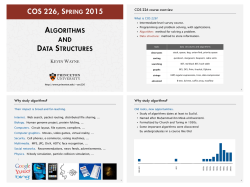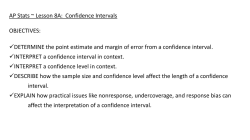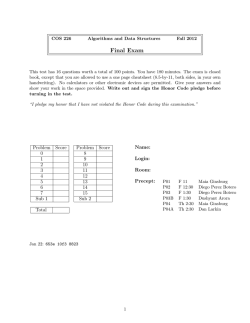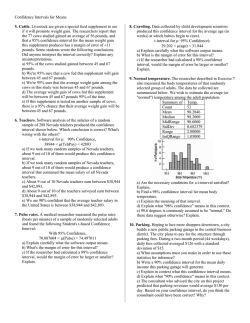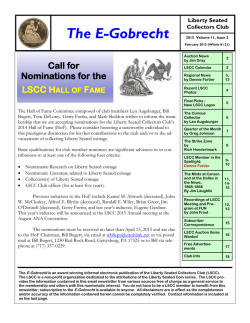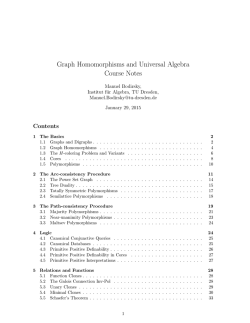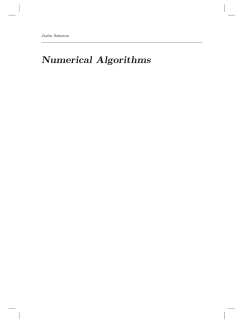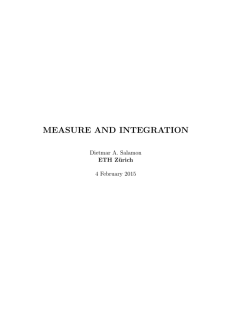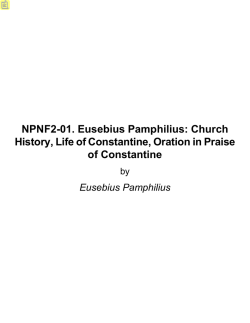
Assignment 3 - CMSC 27200 Theory of Algorithms: Winter 2015
Algorithms – CMSC-27200
http://alg15.cs.uchicago.edu
Homework set #3
due January 28, 2015
Read the homework instructions on the website. The instructions
that follow here are only an incomplete summary.
Hand in your solutions to problems marked “HW.” Do not hand in
problems marked “DO.” If you hand in homework marked “XC” (extra
credit), do so on separate and separately stapled sheets, please.
PRINT YOUR NAME ON EVERY SHEET you submit. We asked you to
use LaTeX to typeset your solutions; starting with this homework, this
is required. Hand in your solutions on paper, do not email.
When writing pseudocode, explain the meaning of your variables.
Use comments to explain what is happening in each line. Also, give a short
explanation of the idea behind the algorithm. Describe all algorithms in
this problem set in pseudocode. Elegance of your code matters.
Carefully study the policy (stated on the website) on collaboration, internet use, and academic integrity.
In this problem set, every digraph is given in an adjacency-list representation, unless expressly stated otherwise. Recall that an adjacency-list
representation consists of an array of vertices, where vertex u is the start
of the linked list Adj[u] that lists all the out-neighbors of u in some order.
An algorithm on a digraph G = (V, E) is said to run in linear time if the
number of steps is O(|V | + |E|).
By “graph” we mean an undirected graph without self-loops and without
parallel edges. A graph is a digraph satisfying the condition that for all
u, v ∈ V , if (u, v) ∈ E then (v, u) ∈ E and (u, u) ∈
/ E.
3.1 DO (Applications of DFS) Study the elegant and sometimes magical linear-time algorithms built on DFS. Read Cormen et al.
(a) Chap. 22-1: find various structural elements of graphs (articulation points, bridges, biconnected components)
(b) Chap. 22-4: topological sort
(c) Chap. 22-5: strongly connected components of a digraph
3.2 DO: review discrete probability, random variables, expected value from
Discrete Mathematics, especially the solved “examples” after the “Linearity of expectation” section in Rosen’s chapter on the expected value
(Chap. 6.4 in the 6th edition).
1
3.3 HW (3+8 points) (Membership cards) The Jolly Spirits Club of
Northern Central Wyoming has 2000 members. The Club decided to
give every member a membership card and to celebrate the event by
serving a glass of vodka to each member. The cards are numbered 1
to 2000. Each member receives a randomly drawn card.
(a) State the size of the sample space (number of possible outcomes)
of this experiment.
(b) A lucky member is a member whose card number agrees with
his or her year of birth. Lucky members receive a small prize.
Determine the expected number of lucky members.
Half the credit for part (b) goes for the clear definition of the random
variables you introduce. Explain the role of vodka in this problem.
(Note: the method used in the solution is important for the analysis
of randomized algorithms.)
3.4 DO: Let an and bn be sequences of non-zero real numbers. We defined
the relation an & bn (“greater than or asymptotically equal”) to mean
bn ∼ min{an , bn }.
(a) Prove: an & bn if and only if an ∼ max{an , bn }.
(b) Prove: if an , bn > 0 then an & bn if and only if for every positive
we have an ≥ (1 − )bn for all sufficiently large n, i.e.,
(∀ > 0)(∃n )(∀n ≥ n )(an ≥ (1 − )bn ).
3.5 HW (8 points) (Sort-of-sorting) Discount Algorithmics, Inc. (DA)
sells algorithms with various performance guarantees. Their “Sort-ofSorting” (SOS) algorithm comes with the rather modest guarantee
that it will correctly sort at least 1% of the n! permutations of any
given list of n distinct real numbers. We are advised that SOS is
comparison-based. DA advertises that “We save on comparisons and
pass the savings on to our customers.” Prove that this is a lie: if the
guarantee is true then SOS must make & n lg n comparisons on some
inputs. (Note: the phrase “on some inputs” is synonymous with “in
the worst case.”) You may use the preceding exercise (about the &
relation) without proof.
3.6 DO (Big-Oh versus induction) Joe claims he can prove that
2n = O(1).
2
His proof goes by induction on n.
Base case: 21 = 2 = O(1).
Inductive step: Assume now that 2n−1 = O(1) (Inductive Hypothesis).
Then 2n = 2 · 2n−1 = 2 · O(1) = O(1). (In the last equation, Joe uses
the fact that 2f (n) = O(f (n)) for any function f (n).) Done.
What’s wrong with Joe’s “proof”?
3.7 DO (Bernoulli trials) Recall from Discrete Mathematics: a Bernoulli
trial is an experiment with two possible outcomes: success (S) and
failure (F). Let p denote the probability of success; we assume 0 < p ≤
1. Let X denote the number of times we need to repeat the experiment
until the first “success” occurs. (We include the first success in the
count. So if the sequence of outcomes is FFFS then X = 4.) Prove:
E(X) = 1/p. (This result plays a role in the analysis of randomized
algorithms.)
3.8 HW (3 points) (Information Theory lower bound) In class we
stated that to identify one out of N objects one must make at least
lg n binary (Yes/No) queries; this is the Information Theory lower
bound for binary queries. (Recall: we use lg to denote base-2 logarithms.) State and prove the Information Theory lower bound for
ternary queries (each query has 3 possible answers).
3.9 (Fake coin algorithms)
(a) DO: Out of 12 given coins we know that exactly one is fake but
we don’t know whether it is heavier or lighter. Given a balance,
use three measurements to find the fake coin and decide whether
it is heavier or lighter than the valid coins. (All the valid coins
have the same weight. You can put any number of coins in each
tray of the balance. Each measurement on the balance results in
one of three possible outcomes: left-heavy, right-heavy, or equal.)
Indicate why your procedure is correct.
(b) XC (3 points) Make your procedure non-adaptive: you need
to tell in advance which coins to put in each tray in each of the
measurements.
3.10 (Fake coin lower bounds)
(a) HW (3 points) Prove: if we have 14 coins in part (a) of the
preceding problem (“Fake coin algorithms”) then three measure3
ments do not suffice. Make your proof very short and elegant
(just a couple of lines).
(b) XC (5 points) Prove: if we have 13 coins in part (a) of the
preceding problem (“Fake coin algorithms”) then three measurements do not suffice. Make your proof short and elegant (couple
of short paragraphs).
Note: A solution to (b) will NOT earn you the 3 points for part (a).
You need to give the even shorter proof of part (a) separately.
3.11 XC (8 points, due February 4) (Counting fake coins) We have
n coins, at least one of which is fake. All the valid coins have the same
weight; all the fake coins have the same weight; the fake coins are
lighter. Find the number of fake coins using O((log n)2 ) measurements
on a balance.
Note: it is an open problem whether or not this could be solved with
o((log n)2 ) or perhaps even with just O(log n) measurements.
3.12 DO (Divide-and-Conquer recurrence)
(a) Study Strassen’s fast matrix multiplication algorithm in the textbook.
(b) Study the handouts “Karatsuba’s algorithm” and “The method
of reverse inequalities.”
(c) Strassen’s algorithm leads to the recurrenct inequality T (n) ≤
7T (n/2) + O(n2 ). Use the method of reverse inequalities to prove
that T (n) = O(nβ ) where β = log2 7 ≈ 2.81.
3.13 (Car race problem) Let R be a subset of the (n + 1)2 points in the
plane with integer coordinates between 0 and n. We call R the “race
track.” One of the points of R is designated as the start (S), another
as the goal (G).
The points are represented as vectors (i, j). Cars are particles sitting
on a point at any time. In one unit of time, a car can move from
a point of R to another point of R, say from (i1 , j1 ) to (i2 , j2 ). The
speed vector of the car during this time unit is defined as the vector
(i2 − i1 , j2 − j1 ).
The acceleration/deceleration of the car is limited by the following
constraint: from any one time unit to the next one, each coordinate
of the speed vector can change by at most one.
4
For instance, if during time unit 6 the car was moving from point
(10, 13) to point (16, 12) then its speed vector was (6, −1) during this
move; during the next time unit, the following are its possible speed
vectors and corresponding destinations:
speed during
time unit 7
(7, 0)
(7, −1)
(7, −2)
(6, 0)
(6, −1)
(6, −2)
(5, 0)
(5, −1)
(5, −2)
location at the end of
time unit 7
(23, 12)
(23, 11)
(23, 10)
(22, 12)
(22, 11)
(22, 10)
(21, 12)
(21, 11)
(21, 10)
Of course only those locations are legal which belong to R (the car
cannot leave the race track).
During time unit 0, the car rests at Start with speed (0, 0). The
objective is to decide whether or not the Goal is reachable at all and
if so, to reach it using the minimum number of time units.
(a) XC (3 points) Construct an example where the optimal route
visits the same point 100 times (at different speeds).
√
(b) HW (4 points) Prove: the speed of the car is bounded by O( n)
at all times. Here we interpret the “speed” as the `1 -norm of the
speed vector, i. e., if the speed vector is (v1 , v2 ) then the “speed”
is |v1 | + |v2 |. Specify the constant you get to justify the big-Oh
claim; the smaller the constant, the better. (Assume n is large.)
(c) HW (7 points) Assume |R| ≥ n. Find an optimal route in
O(|R| · n) time. Describe your solution in clear English statements. Pseudocode not required. Algorithms discussed and analysed in class can be used as subroutines. Prove that your algorithm runs within the time claimed. Hint. Use BFS. Your main
task is to construct the digraph to which to apply BFS. Do not
overlook the possibility stated in part (a).
(d) XC (4 points) Solve the problem in O(|R| · n) time and space
assuming |R| < n. (Note that you are not permitted to use
an array with more than O(|R| · n) cells because of the space
constraint.)
5
3.14 DO (Interval sum) We are given an array A[1 . . . n] P
of real numbers.
The sum of the interval [i, j] is the quantity S[i, j] := jk=i A[k]. Find
the maximum interval sum
Smax = max S[i, j].
1≤i,j≤n
Find this value in linear time (i. e., the number of operations should
be O(n)). Describe your solution in elegant and simple pseudocode.
(Note: you are not required to output the interval with the maximum
sum, just the value of the maximum sum.) Observe the following
convention:
Convention: If j < i, we say that the interval [i, j] is empty; the sum
of the empty interval is zero. Empty intervals are admitted in the
problem. Therefore Smax ≥ 0 even if all the A[i] are negative.
Instructions. Use dynamic programming. Bear in mind that in dynamic programming exercises, half the credit goes for the clear and
simple definition of the array of problems you use (the “brain” of the
solution). Do not confuse the “brain” of the solution with the “heart”
of the solution (the recurrence). Explain the meaning of your variables! Elegance and simplicity count. Do not use notation specific to
some programming language, just the generic pseudocode instructions
appearing in handouts.
6
© Copyright 2025
